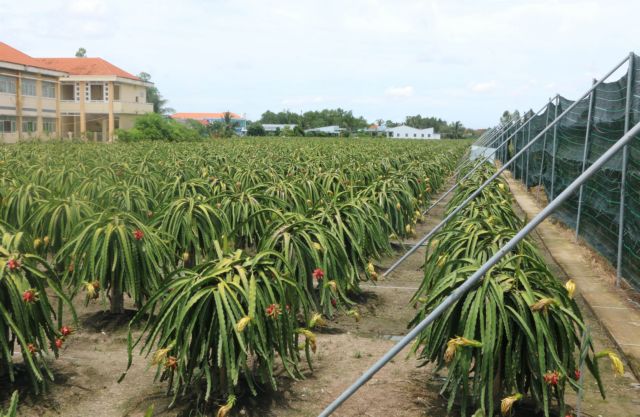 Society
Society


|
| Dragon fruits being grown to organic standards in the Cửu Long (Mekong) Delta province of Long An. – VNA/VNS Photo Bùi Giang |
HCM CITY – Farmers in the Cửu Long (Mekong) Delta are increasingly growing fruits out of season and more efficiently.
In 2013 the Ministry of Agriculture and Rural Development had unveiled plans for growing five key fruits - dragon fruit, mango, rambutan, durian, and longan – during their off-season in the delta’s 12 provinces and Cần Thơ City and the south - central province of Bình Thuận, the country’s largest dragon fruit grower.
This is meant to help avoid oversupply during the regular season, thus ensuring prices never fall too low.
Lê Thanh Tùng, deputy head of the ministry’s plant cultivation department, said the delta and Bình Thuận grow the five fruits off-season on up to 73,800ha of their 132,200ha under them.
Of the 73,800ha, dragon fruit accounts for 45,100ha, durian for 6,300ha, mango for 11,200ha, rambutan for 3,100ha, and longan for 8,100ha. This accounts for about 51 per cent of their total output.
The off-season fruits have 1.5 – 2 times higher economic efficiency than seasonal ones, according to the ministry.
In recent years more and more farmers are adopting good agricultural practices (GAP) standards to grow fruits out of season.
For instance, during the main season durian is sold at orchards at VNĐ35,000 – 40,000 (US$1.5 – 1.7) per kilogramme while off-season fruits fetch VNĐ60,000 ($2.6).
Durian is one of the delta’s key fruits, and has seen high prices and demand in recent years.
Tiền Giang Province, the delta’s largest fruit producer, has more than 130,000ha under durian with an average yield of 25 tonnes per year.
Đào Ngọc Thoại, who owns a 1ha orchard in Cai Lậy District, said during the off-season the fruit fetches 1.7 times the main-season income.
He has been harvesting around 20 tonnes during the former each year, earning profits of more than VNĐ1 billion ($43,400), he said.
Production efficiency
To improve efficiency, research institutes, universities and relevant agencies have transferred techniques for growing fruits during the off-season to farmers, the ministry said.
The Southern Fruit Research Institute would continue to do research, it said.
The ministry has instructed provinces producing off-season fruits to help farmers develop links with companies to secure outlets for their output.
In the delta, Đồng Tháp and Vĩnh Long provinces and a part of Long An and Tiền Giang provinces grow dragon fruit, durian, rambutan, and longan during the off-season.
The ministry said the provinces of Bến Tre and Trà Vinh and a part of Vĩnh Long, Tiền Giang and Long An provinces should ensure there is sufficient irrigation water for fruits this year and to address problems like drought and saltwater intrusion into water bodies.
In the 2020-21 dry season, which usually lasts between last December and April, farmers took several measures to mitigate the impacts of saltwater intrusion on fruit cultivation like storing water in ponds, using rice straws, leaves and plastic sheets to cover tree roots to reduce water evaporation.
They also increased the use of organic fertilisers, lime and bio-products to tend trees, pruned branches, discarded a part of the flowers and young fruits their trees produced to enhance their ability to resist drought and saltwater.
In Tiền Giang, saltwater intrusion caused little damage to durian trees as farmers took effective measures to mitigate it, according to the province Department of Agriculture and Rural Development.
The province has also recovered nearly 1,000ha of durian plants and replanted nearly 2,000ha that were damaged by drought and saltwater in 2019 – 20.
During that dry season nearly 4,500ha of orchards were severely damaged, with 3,500ha being a write-off.
The delta, the country’s largest fruit producer, gradually increased its total area under fruits from 287,300ha in 2010 to 377,700ha last year, or 33.3 per cent of the country’s total, according to the ministry.
The increase focused on dragon fruit, durian, pineapple, mango, grapefruit, banana, rambutan, jackfruit, and orange. – VNS




